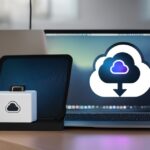Table of Contents
Having your HDD show on the Mac desktop is key for easy file management and better productivity. Sometimes, you might not see the hard drive icon due to updates or setting changes. Getting the icon back means you can access your files quickly and manage both external and Mac hard drives better.
Learning to display the hard drive on Mac can save you from frustration and wasted time. The main reasons for the drive disappearing could be settings, connection issues, or corrupted files. Luckily, there are good fixes for these problems. Knowing how to adjust Finder settings and fix connection problems makes you more in control. For detailed steps on fixing these issues, visit this link: external drive troubleshooting1.
Key Takeaways
- It’s essential to make your HDD visible on your Mac for easy file access.
- Knowing how to use Finder preferences is a big help in handling external drives.
- Typical problems include settings, connection issues, or corrupted files.
- Tools like Disk Utility can show your HDD on your Mac.
- Regular checks and maintenance can prevent issues with external drives.
- In cases of data loss, software like EaseUS and Recoverit can save your data.
Understanding the Importance of Showing the HDD on Your Mac
Having your HDD visible on the Mac Desktop is key to managing files well. It lets you quickly get to important folders like Applications and Libraries. For those with a lot of data, this setup makes things more orderly and boosts productivity.
Seeing your hard drive helps spot storage problems early. About 80% of Mac users back up data or transfer files using external drives2. Showing these drives makes it easier to watch storage levels and catch issues early, improving your Mac’s performance.
Making your HDD visible on your desktop lets you quickly change storage settings. This hands-on approach ensures your Mac runs smoothly. Hiding the HDD can make file management harder, lowering your work speed.
Good file management is possible when you can see and handle your hard drives easily. Having a system that highlights HDD visibility streamlines work and leads to better results and efficiency.
Enhancing your productivity starts with where you can see your files.
So, showing your HDD helps you manage data better, allowing quick file access. It’s crucial for Mac users who want to improve their experience2.
Why You Can’t See Your Hard Drive on Mac
Hard drive disappearance on a Mac involves a few key issues. These include settings changes, connection challenges, and file system damage. Knowing about these helps fix the problem faster.
Preference Issues
Preferences getting reset after a macOS update can hide hard drives. A simple check in Finder settings might fix this. Ensure the hard drive visibility option is ticked to solve it.
Connection Problems
Connection troubles are a big reason for invisible hard drives. It’s vital to check if your USB cable is properly powered. The most common issues come from cable, power, or corrupted drive problems. Investigating these aspects is key to fixing the issue3.
Corrupted File Systems
File system damage is tough to handle. If your disk has errors, it might not show up. Using Disk Utility helps in fixing and finding your hard drives4. Also, drives formatted in NTFS struggle with access, adding more hurdles3.
How to Show HDD on Mac Desktop
Making your hard drive icon show on the Desktop is crucial for tailoring your Mac. It helps you get to your important files easily. By tweaking a few settings in Finder preferences and desktop settings, you can do this with ease.
Accessing Finder Preferences
First, launch Finder on your Mac. Then, from the top menu, choose the Finder option and click on Preferences. This opens a menu for adjustments. There, head to the General tab. It’s where you set what items show on the Desktop. Make sure the “Hard disks” option is ticked. This action will display your HDD on your Desktop, making file access smoother56.
Adjusting the General Settings
You should also show external drives. Just tick the box for External disks. This lets any connected external drives show on your Desktop and in Finder. It’s key for those using external storage a lot. Always check these settings to keep visibility right and use your Mac fully516.
Locating and Showing External Hard Drives on Mac
Getting your external hard drive to show up on your Mac can improve how you use your computer. We will go over how to make your drive visible, check its connection, and fix issues with Disk Utility.
Mounting the External Drive
First, make sure your external hard drive is properly connected to your Mac. Usually, it will show up on the desktop right after you connect it. If it doesn’t, you might have to mount it yourself. Ensure the drive has enough power, as a weak supply can stop it from working. Try using different cables or ports if problems persist. Keep in mind, if your drive is password-protected, it might not mount without entering the password.
Verifying Connection and Format
It’s important to check if your Mac recognizes the external hard drive. Look in your Mac’s System Information under the USB Device Tree. Also, make sure the drive’s format is compatible with macOS. macOS can’t work with NTFS formats without extra software. But, formatting your drive as exFAT or FAT32 can solve this. These formats work with both Mac and PCs. If you still have issues, it’s time to use Disk Utility for a closer look.
Using Disk Utility for Troubleshooting
Disk Utility is great for fixing drive issues. It can tell you whether the drive is just not mounted or if there’s a bigger problem. Use the First Aid feature in Disk Utility to find and fix errors. If your drive won’t mount after this, there might be a serious fault. You may need to consider data recovery or replacing the drive.
Common Issues with External Hard Drives
Mac users often face problems with their external hard drives. Issues like device corruption and connection failures can lead to massive data loss. It’s important to quickly figure out what’s wrong. This way, you can save important files and get your device working again.
Identifying Corrupt Devices
When your external hard drive is corrupted, files might not open, or the drive might run poorly. Sometimes, drives from brands like Seagate or WD won’t appear on the desktop after you update your Mac OS to Monterey 12.01. You can try fixing this by running Disk Utility’s First Aid or by changing Finder’s settings. Resetting the SMC and NVRAM might also help78. If the drive shows in Disk Utility but isn’t mounted, it could mean bigger problems.
Connection Failures and Solutions
Connection issues might come from bad cables or ports. Testing other USB cables, trying different ports, or connecting the drive to a different device can show if the problem is with the drive or the Mac. If your external drive still won’t respond, you might need something like EaseUS Data Recovery Wizard to figure out the problem or get back lost data8. Formatting the drive correctly with Disk Utility can fix issues, especially if it was used with non-Mac devices before. To avoid losing data, keep your important files backed up regularly78.
Using Software Tools to Recover Data
In the world of data recovery, using advanced software helps a lot when you lose data. For Mac users, strong options like EaseUS Data Recovery Wizard and Recoverit are great. They offer strong features designed to get back files effectively from Mac HDDs.
EaseUS Data Recovery Wizard
EaseUS Data Recovery Wizard is known for being easy to use and very effective. It lets users quickly scan for missing files in various formats. A big plus for EaseUS is that it can get back up to 512 MB of data for free. This makes it a good option if you only need to retrieve a little bit of data9. It also has detailed scan options. This means you can recover data from internal, external, and USB drives.
Recoverit Data Recovery Software
Recoverit is a top choice among data recovery tools, offering an easy-to-use recovery process. It works with many file types, making it good for different storage devices. Recoverit is really useful for tough recovery tasks, like when files are corrupted or drives can’t be accessed. It often works when other methods don’t, showing why these tools are essential in our digital age.
EaseUS and Recoverit are solid tools that help people recover lost data easily. They help get back important files and remind us to regularly back up our data10. Having regular backups is important for keeping our data safe.
Best Practices for Hard Drive Management on Mac
Keeping your Mac running smoothly involves good hard drive management. It helps your device last longer and keeps your data safe. By using Disk Utility’s First Aid regularly, you can catch and fix small problems early. This step helps in protecting your files. It’s also smart to keep an eye on your drive’s health to maintain its performance.
Regular Maintenance and Checks
Adding regular checks to your routine is a smart move. You can use Finder or Disk Utility to see how much space you have left. For those using macOS Monterey or earlier, click the Apple icon and choose About This Mac to see storage details. If you’re on macOS Ventura, head to System Settings, then the General tab for the same info11. Also, use Finder to search for big files that you might not need anymore. This helps keep your storage in check.
Data Backup Strategies
Backing up your data well is key to managing your hard drive. Time Machine offers an easy way to do automatic backups. You can also use other tools to help back up your Mac. Make sure to back up important stuff, especially before updates or maintenance. Using iCloud for files like those in Desktop and Documents folders saves space and keeps data safe11. Deleting items you don’t need anymore, like old shows or apps, will also help improve how your Mac runs.
| Backup Method | Advantages | Considerations |
|---|---|---|
| Time Machine | Integrated, automatic backups | Requires external drive or network storage |
| iCloud | Accessibility and sync across devices | Limited storage unless upgraded |
| Third-Party Software | Enhanced features and flexibility | May incur additional costs |
To really take care of your Mac’s hard drive, combine good maintenance with a solid backup plan. These steps will keep your Mac running well and protect your files12.
Conclusion
Learning how to display HDD on your Mac Desktop makes file management smoother and boosts productivity. When you can see your hard drive, finding files becomes faster. Knowing how to fix issues with external drives also helps keep your work flow smooth.
It’s vital for Mac users to understand how to connect and show their hard drives. This includes knowing the risks, like data loss when duplicates show up. Looking into detailed guides, like the one here, helps users manage their data confidently.
To wrap up, using good data recovery techniques and staying up-to-date can improve how you manage your hard drive. This leads to faster access to your data. This means more efficiency and productivity in your daily tasks131415..
FAQ
How do I show my hard drive on my Mac Desktop?
To show your hard drive on the Mac Desktop, open Finder preferences. Click on the Finder menu, choose Preferences, and go to the General tab. Make sure “Hard disks” is selected.
Why has my hard drive icon disappeared after a macOS update?
After a macOS update, the hard drive icon might vanish due to preference changes. You might need to turn on hard drive visibility again in Finder preferences.
What can I do if my external hard drive is not showing on my Mac?
First, ensure your external hard drive is properly connected. Then, in Finder preferences, check if external disks are to be shown. If needed, use Disk Utility to make the drive appear.
How can I recover data from a corrupt hard drive on my Mac?
For a corrupt hard drive, try data recovery software like EaseUS Data Recovery Wizard or Recoverit. These programs can find and recover your lost files.
What should I do if I suspect a connection issue with my external drive?
If there’s a problem connecting your external drive, switch USB cables or ports. See if Disk Utility shows the drive. Try it on another computer to pinpoint the issue.
How can I ensure my hard drive is well-maintained on my Mac?
To keep your Mac hard drive in good shape, use Disk Utility’s First Aid for errors. Always have a backup strategy, like Time Machine, to protect your data.
Q: What are the benefits of displaying my hard drive on the Desktop?
Having your hard drive visible on the Desktop makes managing files easier. It provides quick access to important folders. This setup boosts your productivity by making your workflow smoother.
Source Links
- https://cleanmymac.com/blog/show-hard-drives-desktop – How to show hard drive on Mac Desktop step by step
- https://www.easeus.com/mac-file-recovery/how-to-find-external-hard-drive-on-mac.html – How to Find External Hard Drive on Mac In Case It’s Working but Not Showing Up
- https://setapp.com/how-to/how-to-access-external-drive-thats-not-recognized-on-mac – How to access an external drive that’s not showing up on a Mac
- https://mackeeper.com/blog/external-hard-drive-not-recognized-on-mac/ – External Hard Drive Not Showing Up on Mac
- https://www.easeus.com/computer-instruction/show-hard-drives-on-mac.html – [Solved] How to Show Hard Drives on Mac Desktop
- https://recoverit.wondershare.com/mac-tips/show-hard-drive-mac.html – How to Show Hard Drive on Mac
- https://discussions.apple.com/thread/254572440 – Mac doesn’t recognize external hard drive…
- https://www.easeus.com/mac-file-recovery/mac-external-hard-drive-not-showing-up.html – How to Fix External Hard Drive Not Showing Up Mac | 8 Ways
- https://www.lifewire.com/free-data-recovery-software-tools-2622893 – The 21 Best Free Data Recovery Software Tools of 2024
- https://www.cleverfiles.com/hard-drive-recovery.html – Hard Drive Recovery Software on Mac. Recover HDD [2024]
- https://www.pcmag.com/how-to/how-to-free-up-space-on-mac – Storage Crunch? How to Free Up Space on Your Mac
- https://macpaw.com/how-to/check-storage-on-mac – No title found
- https://iboysoft.com/howto/remove-macintosh-hd-from-desktop.html – How to Remove/Hide Macintosh HD From Desktop? Here Are Ways
- https://community.wd.com/t/g-drive-not-seen-on-macbook/172953 – G Drive not seen on Macbook
- https://www.easeus.com/mac-file-recovery/remove-or-hide-macintosh-hd.html – Remove/Hide Macintosh HD on Mac Desktop








